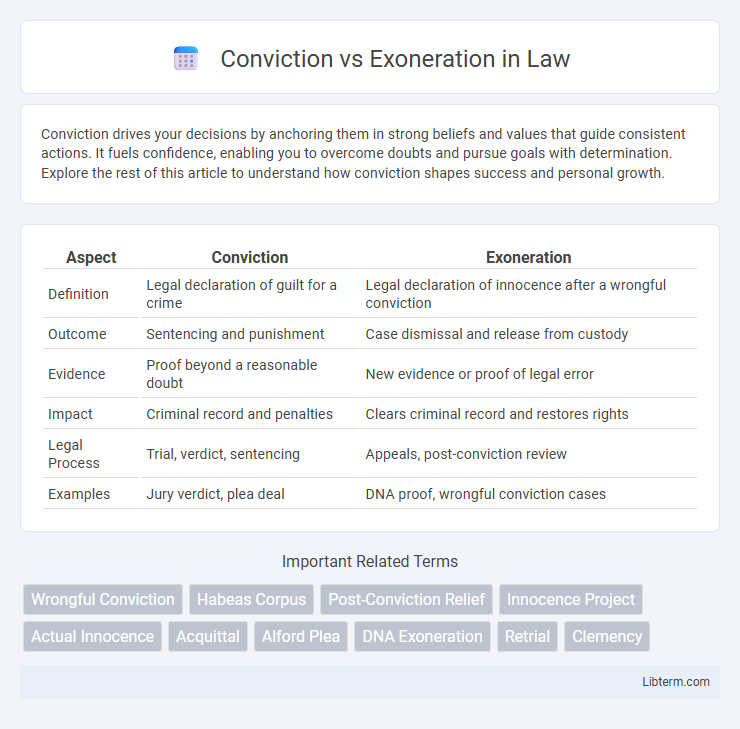Conviction drives your decisions by anchoring them in strong beliefs and values that guide consistent actions. It fuels confidence, enabling you to overcome doubts and pursue goals with determination. Explore the rest of this article to understand how conviction shapes success and personal growth.
Table of Comparison
| Aspect | Conviction | Exoneration |
|---|---|---|
| Definition | Legal declaration of guilt for a crime | Legal declaration of innocence after a wrongful conviction |
| Outcome | Sentencing and punishment | Case dismissal and release from custody |
| Evidence | Proof beyond a reasonable doubt | New evidence or proof of legal error |
| Impact | Criminal record and penalties | Clears criminal record and restores rights |
| Legal Process | Trial, verdict, sentencing | Appeals, post-conviction review |
| Examples | Jury verdict, plea deal | DNA proof, wrongful conviction cases |
Understanding Conviction: Definition and Process
Conviction refers to the formal declaration by a court that a person is guilty of a criminal offense, following a thorough legal process including investigation, trial, and verdict. The process involves presentation of evidence, witness testimonies, and adherence to procedural laws ensuring the defendant's right to a fair trial. Understanding conviction requires awareness of legal standards such as proof beyond a reasonable doubt and the roles of prosecution and defense in establishing guilt or innocence.
What is Exoneration? Key Concepts Explained
Exoneration is the legal process by which a wrongfully convicted individual is officially cleared of all charges, often through new evidence such as DNA testing or witness recantation. It involves overturning a conviction and restoring the individual's legal innocence, highlighting the importance of post-conviction review and justice system safeguards. Key concepts include the reversal of wrongful imprisonment, acknowledgment of judicial error, and the role of innocence projects in securing exonerations.
Legal Standards: Burden of Proof in Conviction vs Exoneration
Conviction requires the prosecution to prove the defendant's guilt beyond a reasonable doubt, the highest standard of proof in criminal law. Exoneration, however, often involves new evidence that meets the burden of proof to conclusively overturn the prior conviction, highlighting flaws or errors in the original trial. Legal standards emphasize that conviction demands certainty of guilt, while exoneration relies on credible proof sufficient to invalidate that certainty and restore the defendant's innocence.
Common Causes of Wrongful Convictions
Common causes of wrongful convictions include eyewitness misidentification, false confessions, and flawed forensic evidence. Inadequate legal defense and prosecutorial misconduct often contribute to these errors, resulting in innocent individuals being convicted. Systemic issues such as cognitive biases and tunnel vision within law enforcement further exacerbate the risk of wrongful convictions.
The Role of New Evidence in Exoneration
New evidence plays a critical role in the exoneration process by challenging the validity of convictions and exposing wrongful imprisonment. Technological advancements, such as DNA testing, have revolutionized the ability to uncover factual inaccuracies, leading to overturned verdicts and restoration of justice. Courts rely heavily on credible new evidence to reassess cases, ensuring that innocence is recognized and convictions are reversed when appropriate.
Social and Psychological Impacts: Conviction vs Exoneration
Conviction often leads to long-term social stigma, loss of employment, and strained relationships, fostering feelings of shame and isolation. Exoneration, while restoring legal innocence, does not always repair damaged social networks or alleviate psychological trauma such as PTSD or anxiety experienced during wrongful imprisonment. The disparity between conviction and exoneration highlights the critical need for comprehensive support systems addressing reintegration, mental health, and stigma reduction in post-conviction recovery.
Notable Cases: High-Profile Convictions and Exonerations
Notable cases of conviction and exoneration reveal profound impacts of DNA evidence and wrongful convictions in the criminal justice system. The Central Park Five case exemplifies high-profile wrongful convictions overturned after years due to new forensic proof and advocacy. Conversely, the conviction of Dzhokhar Tsarnaev for the Boston Marathon bombing underscores the complexities of evidence and sentencing in securing justice for terror-related crimes.
Legal Reforms: Preventing Wrongful Convictions
Legal reforms targeting wrongful convictions emphasize comprehensive measures such as mandatory recording of interrogations, improved eyewitness identification procedures, and expanded access to post-conviction DNA testing. These reforms aim to enhance the accuracy and reliability of evidence, reducing the risk of convicting innocent individuals. Legislatures and advocacy groups continue to push for systematic changes that strengthen safeguards in the criminal justice system and promote fair trials.
The Journey from Conviction to Exoneration
The journey from conviction to exoneration involves a complex legal process where new evidence, such as DNA testing or witness recantations, plays a crucial role in overturning wrongful convictions. Organizations like the Innocence Project utilize advanced forensic science and thorough legal reviews to identify and rectify miscarriages of justice. This process not only restores individual freedom but also highlights systemic flaws in the criminal justice system, prompting reforms to prevent future errors.
Future Trends: Technology and the Changing Landscape of Justice
Advancements in artificial intelligence and digital forensics are revolutionizing the process of conviction and exoneration by enabling more accurate evidence analysis and reducing wrongful convictions. Emerging technologies such as DNA sequencing, biometric data, and blockchain for evidence management enhance transparency and accountability within the justice system. These innovations are driving a paradigm shift toward faster, more reliable resolutions that prioritize both public safety and individual rights.
Conviction Infographic

 libterm.com
libterm.com